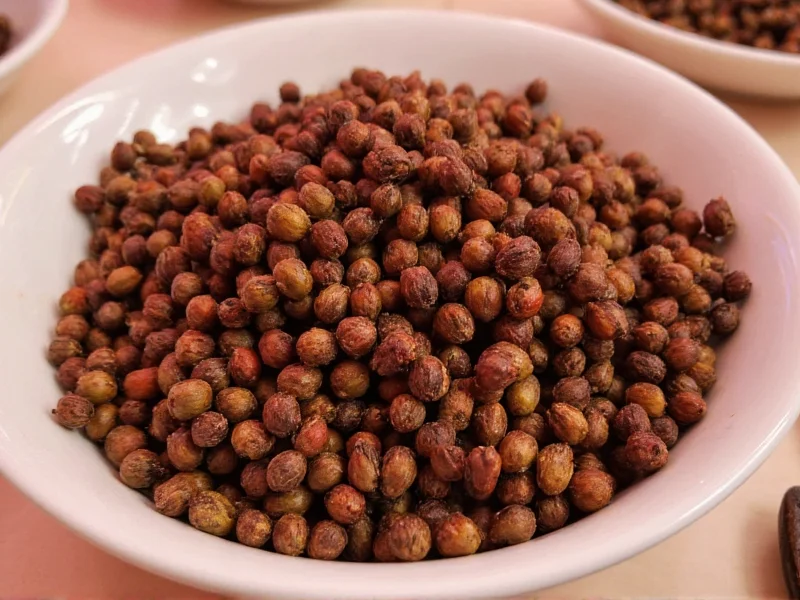Sichuan peppercorns (Huājiāo) create the distinctive málà (numbing-spicy) sensation essential to authentic Sichuan cuisine. Unlike regular peppercorns, they produce a unique tingling, mouth-numbing effect without significant heat. Finding suitable alternatives requires understanding both the flavor profile and the characteristic má (numbing) component that makes these berries irreplaceable in traditional Chinese cooking.
Why Sichuan Peppercorns Are Unique
Sichuan peppercorns aren't actually peppers but the dried husks of berries from the Zanthoxylum genus. Their signature numbing sensation comes from hydroxy-alpha sanshool, a compound that stimulates nerve endings. This creates the famous málà experience when combined with chili heat. Most substitutes can replicate the citrusy, floral notes but struggle to mimic the numbing effect—making substitution a balancing act between flavor and sensation.
Top 5 Sichuan Peppercorn Substitutes Ranked
When selecting alternatives, consider whether your recipe requires the numbing sensation, the citrusy aroma, or both. Here's how the most common substitutes compare:
| Substitute | Numbing Effect | Flavor Profile | Best For | Substitution Ratio |
|---|---|---|---|---|
| Sansho Pepper | ★★★☆☆ | Citrusy, floral, mild numbing | Japanese dishes, light sauces | 1:1 |
| Black Pepper + Chinese Prickly Ash | ★★☆☆☆ | Peppery with citrus notes | Most Chinese recipes | ½ black pepper + ½ prickly ash |
| Tellicherry Peppercorns | ★☆☆☆☆ | Complex, woody, less sharp | Westernized Chinese dishes | ½ amount |
| Aleppo Pepper + Citrus Zest | ☆☆☆☆☆ | Mild heat, fruity, citrusy | Non-traditional applications | 1:1 + zest of ½ lemon |
| Asafoetida (Hing) | ★☆☆☆☆ | Pungent, umami, onion-garlic | Vegan "umami" boost | Pinch per serving |
Detailed Substitute Analysis
Sansho Pepper: The Closest Relative
Sansho pepper (Zanthoxylum piperitum) comes from the same plant family as Sichuan peppercorns and provides the most similar numbing sensation. Native to Japan, it has a lighter, more citrus-forward profile with less earthiness. When using sansho pepper as a Sichuan peppercorn replacement, use equal amounts but expect a brighter, less complex flavor. This works particularly well in dishes where the numbing sensation is crucial but the deep roasted notes aren't essential.
Black Peppercorns + Chinese Prickly Ash: The Practical Duo
For home cooks without access to specialty ingredients, combining regular black peppercorns with Chinese prickly ash powder creates the most balanced alternative. The black pepper provides heat while the prickly ash (available at most Asian markets) contributes the numbing element. Use half the amount of black pepper compared to Sichuan peppercorns, plus an equal amount of prickly ash powder. This combination works exceptionally well in mapo tofu and other classic Sichuan dishes where both heat and numbing are required.
Tellicherry Peppercorns: The Flavor-Focused Option
Tellicherry peppercorns, harvested at full maturity, offer complex citrus and floral notes that somewhat mimic Sichuan peppercorns' aromatic profile. While they lack the numbing sensation, their nuanced flavor makes them suitable for recipes where the tingling effect isn't critical. Use only half the amount called for in your recipe, as Tellicherry has more pronounced heat. This substitute shines in dry-fried dishes and marinades where the numbing component plays a secondary role.
Aleppo Pepper with Citrus Zest: The Accessible Alternative
When specialty ingredients aren't available, combining Aleppo pepper's mild heat with lemon or orange zest approximates Sichuan peppercorns' citrusy dimension. The zest provides the aromatic quality while Aleppo's moderate heat stands in for the peppercorns' warmth. Though this substitute completely misses the numbing sensation, it works surprisingly well in stir-fries and noodle dishes where the primary goal is flavor complexity rather than authentic málà. Add zest during the final minutes of cooking to preserve volatile oils.
Pro Tips for Successful Substitution
Understanding when and how to incorporate your substitute makes all the difference in recipe outcomes:
- Timing matters: Unlike Sichuan peppercorns which are often toasted first, most substitutes should be added later in cooking to preserve delicate flavors
- Grind fresh: Pre-ground alternatives lose potency quickly—invest in a dedicated pepper mill for substitutes
- Balance with acid: A splash of rice vinegar can help mimic the bright quality of authentic Sichuan peppercorns
- Layer flavors: Combine two substitutes (like Tellicherry with a pinch of asafoetida) for more complex results
- Adjust for dish type: Use more numbing-focused substitutes in hot pot broths, flavor-focused options in dry-fried dishes
Where to Find Authentic Sichuan Peppercorns
Before settling for substitutes, consider these reliable sources for genuine Sichuan peppercorns:
High-quality red Sichuan peppercorns (Hong hua jiao) should be bright rust-red with minimal black seeds. Look for products labeled Huajiao from Sichuan province, preferably vacuum-sealed to preserve volatile oils. Online retailers specializing in Chinese ingredients often carry superior quality compared to generic supermarket versions. When properly stored in an airtight container away from light, authentic Sichuan peppercorns maintain potency for 6-12 months—significantly longer than most substitutes.
Common Substitution Mistakes to Avoid
Many home cooks make these critical errors when replacing Sichuan peppercorns:
- Using too much black pepper, creating overwhelming heat without the numbing counterpoint
- Adding substitutes too early in cooking, burning delicate citrus notes
- Ignoring the importance of toasting—most substitutes benefit from light toasting
- Expecting identical results—understand substitutes create different, not identical, experiences
- Using pre-ground alternatives that have lost their volatile aromatic compounds











 浙公网安备
33010002000092号
浙公网安备
33010002000092号 浙B2-20120091-4
浙B2-20120091-4